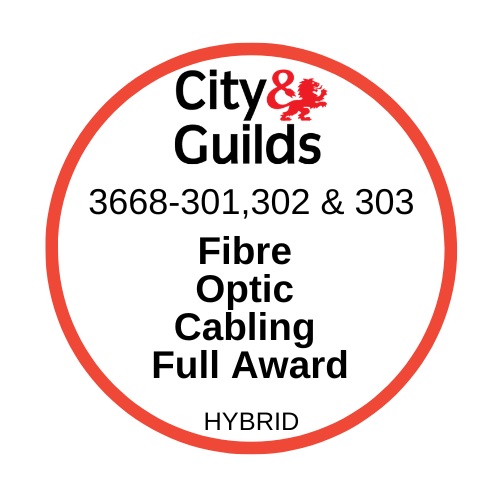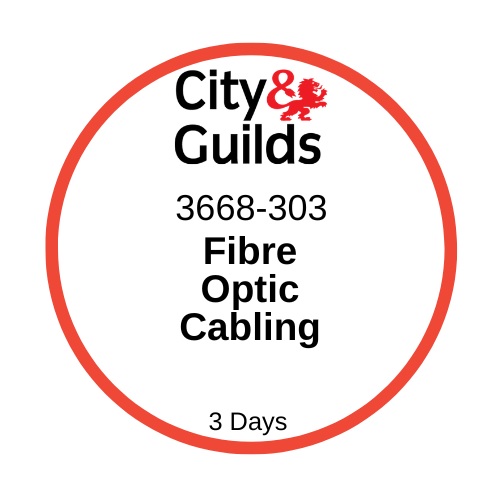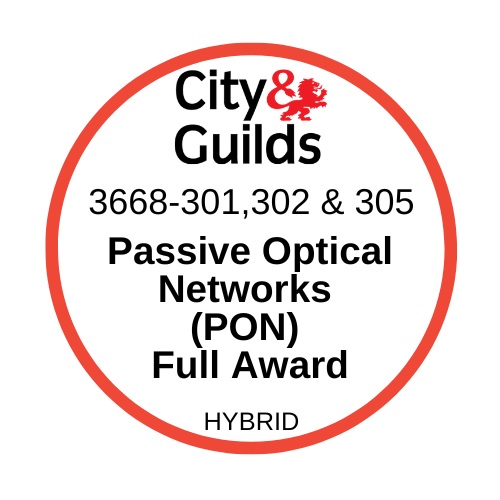CITY AND GUILDS HYBRID LEVEL 3 COURSES – 3668 – 03, Unit 301, 302 & 303 – HYBRID Level 3 Fibre Optic Cabling Full Award
£1,953.60 Inc.VAT | £1,628.00 Ex.VAT
CITY AND GUILDS HYBRID LEVEL 3 COURSES – 3668 – 03, Unit 301, 302 & 303 – HYBRID Level 3 Fibre Optic Cabling Full Award
The qualification will be referencing the BSEN50173 and BEN50174 series of standards
This Level 3 5 Day Core Modules & Fibre Optic Cabling Units 301, 302 & 303 course aims to provide the delegate with the opportunity to evaluate the most appropriate fibre optic cabling that are commonly available in the communications cabling industry.
Delegates will develop their knowledge and understanding of different types of fibre, their uses and some of the standards associated with them.
Delegates will also build upon their knowledge of fibre testing techniques and when these are applied.
CORE MODULES:
Unit 301: The aim of this unit is to enable delegates to gain an understanding of the safety, to develop and increase the knowledge required for safety, including safe working practices and behaviours, whether working in an internal network and in the external network, including underground, overhead and the public highway.
Unit 302: The aim of this unit is to enable delegates to gain an understanding of the fundamental of telecoms transmission technologies.
Our training centre is located in Harlow in the South East of England just off the M25. We can also deliver courses at your location by arrangement if you have a suitable workspace.
*use voucher code tct5 at checkout for 5% discount
Description
CITY AND GUILDS HYBRID LEVEL 3 COURSES – 3668 – 03, Unit 301, 302 & 303 – HYBRID Level 3 Fibre Optic Cabling Full Award
Course details…
Availability
Dates on request
Duration
Hybrid – 5 Days
Eligibility Criteria
PLEASE be aware To be accepted onto attendance of this Hybrid course, candidates MUST provide verifiable evidence of having achieved City & Guilds Level 2 in Communcations Cabling. This may be achieved by providing the certificate, or enrolment number if undertaken previously with us. We are here to advise and we welcome you to contact us if you have any questions.
It is aimed at *experienced* Data and Fibre Optic cabling Engineers who are currently installing and testing a full range of class D/Class E/Class EA and MM/SM fibre optic systems and are seeking to obtain a Level 3 Qualification in Network Infrastructure, Enterprise Networks, PON and other systems utilising a range of communications cabling systems.
If your unsure of the route you need we would strongly recommend that you take the City & Guilds 3668 Level 2 qualification first. Click HERE for Level 2 details
Course Content
Unit 301: Safe Working Practices and Behaviours:
- Describe the primary safety legislation and safety regulations relevant to the communications cabling and telecommunications industry.
- Describe key factors of health and safety, personal health and wellbeing
- Describe comprehensive risk assessments, method statements and permit to work in all aspects of underground, overhead and internal networks.
- The principles of conducting a site survey
- Describe and produce a plan for a road works guarding configuration set up
- Describe the deployment of road works guarding in accordance with a site plan.
- Confined spaces including underground chamber safety access
- Responding appropriately to emergencies.
- Working at heights including electrical hazards
- Describe and identify asbestos hazards and legal requirements
- Describe and identify the correct fire stopping materials as appropriate
- Describe the SSOW: safe system of work for voltage/metal/stud detection to identify hidden services and the selection of a safe place to drill.
- Describe processes for carrying out effective communication with customers appropriately.
- Describe the processes for effective communication with peers
- Describe the processes for effective communication with manager.
Unit 302: Telecoms Fundamentals:
- Describe the characteristics of transmission technologies
- Describe the applications in digital networks.
- Describe the uses of different types of media associated with data and telecommunications networks.
- Describe the characteristics of different media that are used as part of data and telecommunications networks.
- Describe data transmission methods used as part of data and telecommunications networks.
- Describe the role of the organisations that are responsible for establishing telecoms and data network standards
- Describe the layers of the OSI model and function of each layer, referencing the TCP/IP model.
- Describe the purpose of standards associated with data and telecommunications networks
- Describe the role of protocols in data and telecommunications networks.
Unit 303 Fibre Optic Cabling:
- Describe and explain the advantages and disadvantages of different fibre optic types according to their specifications
- describe the different transmitting characteristics for different types of cabling.
- Evaluate and describe the transmission characteristics, operating parameters of fibre optic cables and their appropriate uses.
- Describe and identify the different characteristics of types of fibre optic cable, i.e., G651 (MM) G652 etc
- Describe the usage fibre optics cable and explain operational considerations, i.e., bandwidth, attenuation, nodes, splitters etc, including effects on anticipated performance.
- Describe and explain the appropriate fibre optic cabling standards, both national and international
- select and explain testing methodologies in fibre optic cabling; i.e., VFL/VLS, end face inspection (and criteria used) OLTS, OTDR, COOTDR, CD, PMD, OSA etc.
- Note: there is a practical assessment to be undertaken as part of achieving this
Assessment
- Candidates are required to attend the centre for 1 Full Day to receive the Unit assignments
- You will have 8 weeks to complete and submit all assignments
- Candidates will have dedicated technical email support with optional MS Teams support available if required
- Once assignments are submitted you will be required to call the centre to book your completion day which will include a review and feedback along with the practical assessment
Please note:
All candidates associated assignments are marked internally by a nominated and City and Guilds approved assessor.
These assignments will be subject to a quality audit by the awarding body
Price Breakdown
This course is subject to vat and is inclusive of all examination fees.
Certificates are sent via email as PDF. If you require a Hard Copy Certificate £5.00 P&P is required.
Additional information
| PRODUCT TYPE | TRAINING COURSE, CITY AND GUILDS HYBRID LEVEL 3 COURSES |
|---|
Related products
Contact Us
Fax: 01322 553922
Bownet Cable Management Systems Ltd.
Registered address:
23 Acorn Industrial Park
Crayford Road
Dartford
Kent DA1 4AL
Registered in England No. 2358940
VAT No. 625 607149
sales@bownet.co.uk
Offices & Trade Counter
Monday - Friday
Useful Information
About Bownet CMS
Safe and Secure









Follow Us: